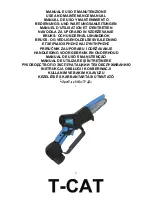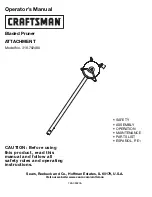
should operate automatically.
g)
Always observe that the lower guard is covering the blade before placing saw down on bench
or floor. An unprotected, coasting blade will cause the saw to jump, cutting whatever is in its path.
Be aware of the time it takes for the blade to stop after switch is released.
h)
NEVER hold piece being cut in your hands or across your leg. It is important to support the
work properly to minimize body exposure, blade jamming, or loss of control.
i)
Always hold tool by the insulated gripping surfaces when performing an operation where the
cutting tool may contact hidden wiring or its own cord. Contact with a “live” wire will also make
exposed metal parts of the tool “live” and shock the operator.
j)
DO NOT use any other blades than the Twin Cutter Blades specially designed for this tool.
Other blades do not match the mounting hardware & will cause loss of control.
k)
Never use damaged or incorrect flanges (drivers) or bolts. The flanges (drivers) & bolts are
specially designed for your saw, for optimum performance and safety of operation.
l)
DO NOT run the saw while carrying it. Lower Guard may be opened by a contact with your
clothing. Accidental contact with the spinning saw blade could result in serious personal injury.
m)
“Never attempt to operate saw with only one blade”. Kickback will occur and send the saw
towards you resulting in serious injury.”
n)
Always wear the protective equipment (gloves, footwear, hearing/eye/respiratory protections,
etc.) when cutting metal part.
o)
Do not let anyone under the age of 18 years operate this saw.
CAUSES AND OPERATOR PREVENTION FROM KICKBACK
FURTHER SAFETY INSTRUCTIONS FOR ALL SAWS - Kickback causes and related warnings
Causes and operator prevention of kickback:
y
kickback is a sudden reaction to a pinched, bound or misaligned saw blade, causing an
uncontrolled saw to lift up and out of the workpiece toward the operator;
y
when the blade is pinched or bound tightly by the kerf closing down, the blade stalls and the
motor reaction drives the unit rapidly back toward the operator;
y
if the blade becomes twisted or misaligned in the cut, the teeth at the back edge of the blade
6







































